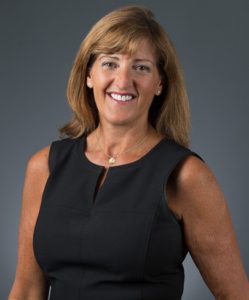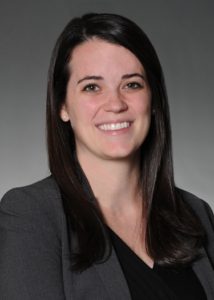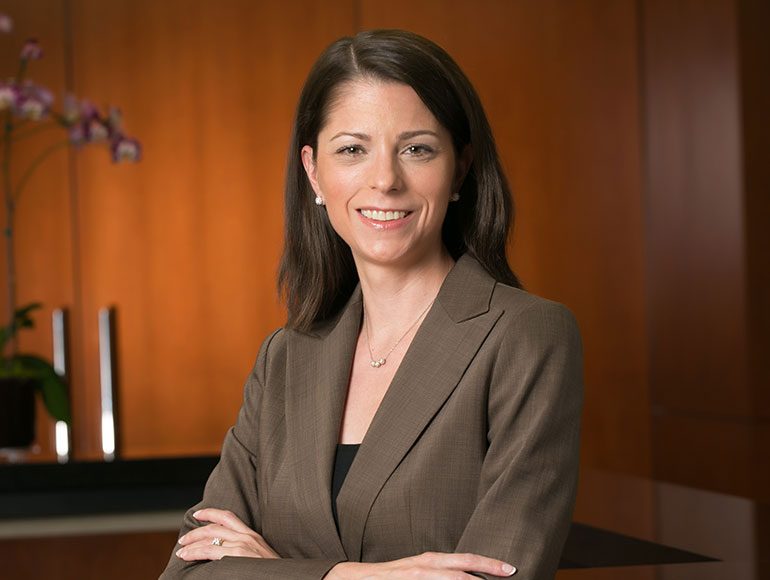August 2021 Spotlight on Flex
Our Spotlight on Flex showcases professionals from member organizations who exemplify personal and professional success while working a flexible schedule. Their stories illustrate the long-term benefits that flexible schedules offer to both individuals and organizations.
For our August 2021 Spotlight on Flex we are pleased to share insights from Roberta Granadier, Of Counsel, at Dickinson Wright.
 Diversity & Flexibility Alliance: How have you made flexibility a priority and a success with your schedule? How have the firm and/or your clients contributed to this?
Diversity & Flexibility Alliance: How have you made flexibility a priority and a success with your schedule? How have the firm and/or your clients contributed to this?
Roberta Granadier: I have been working a reduced schedule for more than thirty years since my first child was born. I intentionally made my work schedule Monday through Thursday to enable me to participate in school activities for my kids when they were younger. It was also easier for my clients and colleagues to know which days I would be in the office. Clients have known throughout my career that I work a reduced hours schedule, but I’ve always ensured that they had access to my cell phone number and could reach me in case of emergency. The key for me has been being as responsive and prompt as possible with all of my clients. . In turn, my clients have respected my schedule and have been very apologetic on those times when they’ve needed to reach me on a Friday.
Generally, I have found that law firms are enlightened about reduced work schedules. Part of the reason I have been able to find success in working a flexible schedule is that I simultaneously always provide superior client services while also having a niche legal specialty in ERISA. The combination of having a unique specialty and being indispensable to clients and firms has really allowed me to thrive.
DFA: How has working flexibly made your career more sustainable and contributed to business development opportunities?
RG: Working flexibly has made my career more sustainable because I can successfully juggle my work responsibilities with other priorities that are important to me, such as my family, community involvement, and nonprofit activities. These non-work activities have also contributed to business development opportunities. I continue to be energized by my practice specialty and teamwork with colleagues.
DFA: Looking back, would you do anything differently, or what would you tell your first year associate self?
RG: One thing I would tell myself, and that I would tell anyone considering a flexible work schedule, is to be very candid and specific about your goals and expectations. Personally, I’ve always been up-front with my firms and my clients about when and how many hours I expected to be working. Obviously, this can fluctuate over time based on a number of factors, but I think it is important to remain intentional about my schedule. This candidness has been useful to me in my career, and I have been able to maintain a flexible schedule with multiple firms as a result.
DFA: How do you recharge, and how do you pay it forward?
RG: Aside from my family and my community involvement outside of work, I genuinely get recharged by feeling like I am providing value to my firm, my colleagues, and my clients. I recognize that I am an expert in an area of the law that most people don’t know much about, so I enjoy and have benefited from being able to explain complex law in a way that others can understand. For my clients in particular, I am providing them an overview of risks and options that help them make the most informed decisions for their organizations.
As it relates to paying it forward, I’ve always found it important to describe my schedule to other attorneys, especially younger women, who might also be interested in working reduced hours. I’m very open about how my career has developed, and I enjoy sharing with other attorneys how you can have a very successful career with a flexible schedule. Over the years I have also enjoyed participating in recruiting events at our feeder law schools to talk about the arc of my career.
DFA: How has the pandemic impacted your flexible working schedule?
RG: I have enjoyed working from home and it is actually easier for me to be more productive with my time. Especially earlier in the pandemic when a Saturday seemed the same as a Tuesday, and because I was very busy, I ultimately ended up billing more than previously. This is a good problem to have! Although I do miss seeing my colleagues, it has been easy to connect through Zoom meetings and occasional walks with local colleagues.
Dickinson Wright’s remote work policy has also allowed me to spend a bit more time doing other things that are important to me. That said, the firm has always allowed attorneys to work flexibly with minimal oversight. This is largely a feature of how the firm trusts its attorneys: we’ve always had a significant amount of professional autonomy. This amount of trust makes Dickinson Wright a very healthy place to practice law and a great place to do so on a flexible work schedule.
 Jessamine Lee: Flexibility has been a key to my success at Wolf Greenfield. After coming back to work from having my first child 11 years ago, I went on an 80% schedule. I was a junior associate at the time. I stayed on an 80-90% schedule through having my second child three years later and then becoming Counsel and a Shareholder at the firm. During that same time, I also had a flexible arrangement in which I worked remotely twice a week. The firm was supportive of my requests and made it possible for me to have this alternative work arrangement during a time when it was not common to do so. I had a lot of help from my colleagues. For example, at times when my workload was too high, I was able to transfer work to other colleagues who had more bandwidth at the time. This is a testament to Wolf Greenfield’s collegiality and culture – we work as a team. I also set boundaries, made expectations clear to both my colleagues and clients as to when I was available, and inquired about firm and client expectations as well. Of course, there were times when urgent projects needed to get done, but for the most part everyone was respectful of these boundaries and I was able to meet the expectations of those I worked with.
Jessamine Lee: Flexibility has been a key to my success at Wolf Greenfield. After coming back to work from having my first child 11 years ago, I went on an 80% schedule. I was a junior associate at the time. I stayed on an 80-90% schedule through having my second child three years later and then becoming Counsel and a Shareholder at the firm. During that same time, I also had a flexible arrangement in which I worked remotely twice a week. The firm was supportive of my requests and made it possible for me to have this alternative work arrangement during a time when it was not common to do so. I had a lot of help from my colleagues. For example, at times when my workload was too high, I was able to transfer work to other colleagues who had more bandwidth at the time. This is a testament to Wolf Greenfield’s collegiality and culture – we work as a team. I also set boundaries, made expectations clear to both my colleagues and clients as to when I was available, and inquired about firm and client expectations as well. Of course, there were times when urgent projects needed to get done, but for the most part everyone was respectful of these boundaries and I was able to meet the expectations of those I worked with.
 Katelyn Miller: Upon returning from maternity leave after the birth of my first child in 2015, I transitioned to an alternative schedule. I had wonderful role models at my prior firm who guided me through the process of requesting and moving to a flexible schedule. When my daughter was one, I moved to Seyfarth. After receiving an offer, I very nervously called the head of our Litigation Department and asked whether I could join the firm on an 80% schedule. Within hours, I received a response that Seyfarth would be happy to accommodate my schedule. It was clear from the beginning that in addition to providing exceptional client service, Seyfarth truly valued its team members and provided different opportunities and avenues for its professionals to succeed.
Katelyn Miller: Upon returning from maternity leave after the birth of my first child in 2015, I transitioned to an alternative schedule. I had wonderful role models at my prior firm who guided me through the process of requesting and moving to a flexible schedule. When my daughter was one, I moved to Seyfarth. After receiving an offer, I very nervously called the head of our Litigation Department and asked whether I could join the firm on an 80% schedule. Within hours, I received a response that Seyfarth would be happy to accommodate my schedule. It was clear from the beginning that in addition to providing exceptional client service, Seyfarth truly valued its team members and provided different opportunities and avenues for its professionals to succeed. Liz Dillon, Partner, Lathrop GPM LLP
Liz Dillon, Partner, Lathrop GPM LLP Elise Attridge: After my first child was born in 2016, I started working at an 80% reduced hour schedule. At that time, I had been a Litigation Associate at Morgan Lewis for five years.
Elise Attridge: After my first child was born in 2016, I started working at an 80% reduced hour schedule. At that time, I had been a Litigation Associate at Morgan Lewis for five years. Diversity & Flexibility Alliance: How have you made flexibility a priority and a success with your schedule? How has the firm and/or your clients contributed to this?
Diversity & Flexibility Alliance: How have you made flexibility a priority and a success with your schedule? How has the firm and/or your clients contributed to this? Diversity & Flexibility Alliance: How have you made flexibility a priority and a success with your schedule? How have the firm and/or your clients contributed to this?
Diversity & Flexibility Alliance: How have you made flexibility a priority and a success with your schedule? How have the firm and/or your clients contributed to this? Diane Crabtree: I began working at Bracewell in the litigation group after graduating from law school in 2004. My career path has been far from traditional at a big law firm. After the birth of my first child in 2007, I initially took a leave of absence to stay home with my daughter. Although I cherished this time at home, after a year I started to crave intellectual stimulation and decided to return to work. I was thrilled when Bracewell welcomed me back and offered me several potential flexible arrangements. I decided on a 75% reduced budget arrangement and maintained this schedule for several years. After trying a couple of different schedules, I found that I prefer to work every day but to leave at 4 p.m. to be home for dinner and after-school events.
Diane Crabtree: I began working at Bracewell in the litigation group after graduating from law school in 2004. My career path has been far from traditional at a big law firm. After the birth of my first child in 2007, I initially took a leave of absence to stay home with my daughter. Although I cherished this time at home, after a year I started to crave intellectual stimulation and decided to return to work. I was thrilled when Bracewell welcomed me back and offered me several potential flexible arrangements. I decided on a 75% reduced budget arrangement and maintained this schedule for several years. After trying a couple of different schedules, I found that I prefer to work every day but to leave at 4 p.m. to be home for dinner and after-school events.  Maryam Casbarro: I formally started working a flex schedule in January of this year. It was brought about by life circumstances. In October of 2019 I found out that my baby would be born with special needs. We anticipated that she would have significant medical needs going into 2020, but of course we didn’t anticipate there would also be a pandemic! So I had a conversation with the chair of my practice on what work would look like returning from maternity leave with my baby still in the hospital.
Maryam Casbarro: I formally started working a flex schedule in January of this year. It was brought about by life circumstances. In October of 2019 I found out that my baby would be born with special needs. We anticipated that she would have significant medical needs going into 2020, but of course we didn’t anticipate there would also be a pandemic! So I had a conversation with the chair of my practice on what work would look like returning from maternity leave with my baby still in the hospital.
 Margaux Trammell: I began my legal career in Switzerland before earning my LLM in American and comparative law and J.D. from the University of Denver Sturm College of Law in the U.S. I joined Brownstein Hyatt Farber Schreck over 15 years ago as a second-year corporate associate, where my practice focused on outside general counsel representation, mergers and acquisitions, joint ventures, corporate reorganizations and finance matters. I became a shareholder at the firm in due course shortly after welcoming my first child.
Margaux Trammell: I began my legal career in Switzerland before earning my LLM in American and comparative law and J.D. from the University of Denver Sturm College of Law in the U.S. I joined Brownstein Hyatt Farber Schreck over 15 years ago as a second-year corporate associate, where my practice focused on outside general counsel representation, mergers and acquisitions, joint ventures, corporate reorganizations and finance matters. I became a shareholder at the firm in due course shortly after welcoming my first child.